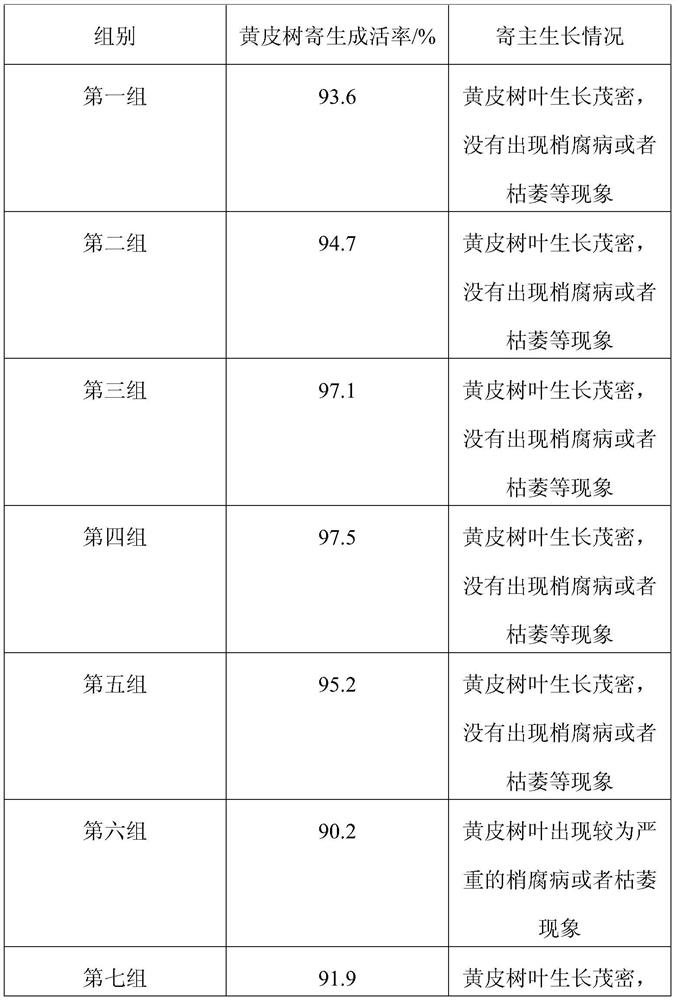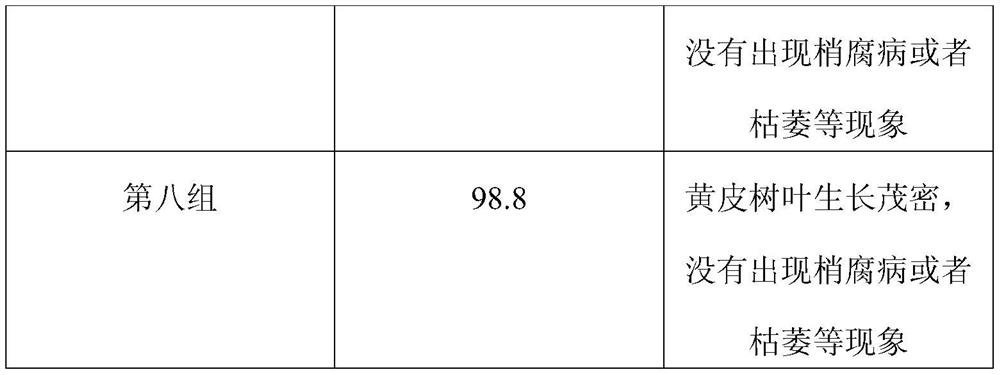Method for increasing parasitic yield of Phellodendron sinii Y.C Wu
A technology for yield and saplings, which is applied in the field of increasing the parasitic yield of xanthophyllum, can solve problems such as the parasitic yield of xanthophylla being unable to meet demand, and achieves the effects of treating influenza, reducing damage and reducing uric acid.
- Summary
- Abstract
- Description
- Claims
- Application Information
AI Technical Summary
Problems solved by technology
Method used
Image
Examples
Embodiment 1
[0033] A kind of method that the present embodiment provides to improve the parasitic yield of wampum bark comprises the following steps:
[0034] (1) Cultivation of the host: select the young yellow bark saplings, plant them on high-lying plots, use loose soil rich in organic matter to bury in the planting process, and evenly bury organic fertilizer at 0.4m away from the root parts of the yellow bark saplings, Cultivate for 1 month; the organic fertilizer is obtained by mixing cow dung, coconut peat and leaf humus according to the mass ratio of 3:1:1, then composting and fermenting for 2 days;
[0035] (2) Prepare the parasitic buds of the yellow bark tree: cut the parasitic tree of the yellow bark tree with leaf buds, the length is 3cm, cut the incision into a tongue-shaped slope, and cut off 1 / 2 leaves to obtain the parasitic buds of the yellow bark tree, then Soak the parasitic buds and spikes of the yellow bark tree in the nutrient solution for 10 minutes; the nutrient so...
Embodiment 2
[0040] A kind of method that the present embodiment provides to improve the parasitic yield of wampum bark comprises the following steps:
[0041] (1) Cultivation of the host: select the young yellow bark saplings, plant them on high-lying plots, use loose soil rich in organic matter to bury in the planting process, and evenly bury organic fertilizer at 0.4m away from the root parts of the yellow bark saplings, Cultivate for 2 months; the organic fertilizer is obtained by mixing cow dung, coconut peat and leaf humus according to the mass ratio of 4:1:1, then composting and fermenting for 3 days;
[0042] (2) Preparing the fringe of the parasitic buds of the yellow bark tree: clipping the parasitic buds of the yellow bark tree with leaf buds, the length is 3.5cm, cutting the incision into a tongue-shaped inclined plane, and cutting off 1 / 2 leaves to obtain the parasitic buds of the yellow bark tree, Then soak the parasitic buds and ears of the yellow bark tree in the nutrient s...
Embodiment 3
[0047] A kind of method that the present embodiment provides to improve the parasitic yield of wampum bark comprises the following steps:
[0048] (1) Cultivation of the host: select the young yellow bark saplings, plant them on high-lying plots, use loose soil rich in organic matter to bury in the planting process, and evenly bury organic fertilizer at 0.5m away from the root parts of the yellow bark saplings, Cultivate for 2 months; the organic fertilizer is obtained by mixing cow dung, coconut peat and leaf humus according to the mass ratio of 5:1:1, then composting and fermenting for 4 days;
[0049] (2) Preparing the parasitic buds of the yellow bark tree: cutting the parasitic tree of the yellow bark tree with leaf buds, the length is 4cm, cutting the incision into a tongue-shaped slope, and cutting off 1 / 2 leaves to obtain the parasitic buds of the yellow bark tree, then Soak the parasitic buds and ears of the yellow bark tree in the nutrient solution for 15 minutes; th...
PUM
 Login to View More
Login to View More Abstract
Description
Claims
Application Information
 Login to View More
Login to View More - R&D
- Intellectual Property
- Life Sciences
- Materials
- Tech Scout
- Unparalleled Data Quality
- Higher Quality Content
- 60% Fewer Hallucinations
Browse by: Latest US Patents, China's latest patents, Technical Efficacy Thesaurus, Application Domain, Technology Topic, Popular Technical Reports.
© 2025 PatSnap. All rights reserved.Legal|Privacy policy|Modern Slavery Act Transparency Statement|Sitemap|About US| Contact US: help@patsnap.com


